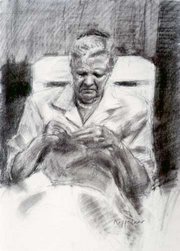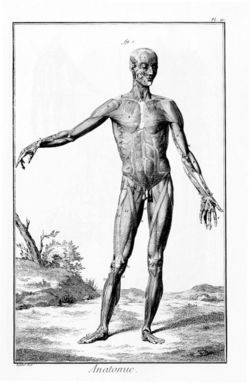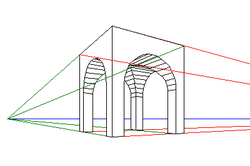Drawing
2007 Schools Wikipedia Selection. Related subjects: Art
Drawing is the act of defining (or delineating) the outlines of a figure against a background, using any of a wide variety of tools and techniques. It generally involves making marks on a surface by applying pressure from a tool, or moving a tool across a surface. Common tools are graphite pencils, pen and ink, inked brushes, wax colour pencils, crayons, charcoals, pastels, and markers. Digital tools which simulate the effects of these are also used. An artist who excels in drawing is referred to as a draftsman or draughtsman.
Definitions
Drawing is distinct from "painting", in which delineated areas are "filled in" with a colour, or pattern. The terms "drawing" and "painting" are often confused, because the same tool can perform both tasks. But the operations are distinct, as the designers of graphics software applications recognized when they distinguished "path" and "fill" tools.
Subject matter
Most drawings are representational, depicting objects or scenes which the artist views, remembers, or imagines. They may be realistic to the point of lifelike resemblance (e.g. traditional portraits), looser approximations of reality (e.g. sketches), highly stylized (e.g. cartoons, caricatures), or abstract (e.g. automatic drawing, entoptic graphomania).
Materials
Paper comes in a variety of different sizes and qualities, ranging from newspaper grade for practice up to high quality and relatively expensive paper sometimes sold as individual sheets. Papers can vary in texture, hue, acidity, and strength when wet. Smooth paper is good for rendering fine detail, but a more "toothy" paper will hold the drawing material better. Thus a more coarse material is useful for producing deeper contrast.
For pen and ink work, typing paper is often used for practice drawings, but heavier paper holds up better. Bristol board makes a hard surface that is especially good for ink or fine detailed graphite drawing. Coldpressed watercolor paper is sometimes favored for ink drawing due to its texture. Tracing vellum is often used for experimenting on top of a pencil drawing, prior to committing a technique to the final page.
Various tools are routinely used in the process of drawing. These include a pencil sharpener, sandpaper, kneaded eraser, blending stumps, and chamois. Other tools that sometimes prove useful are tracing paper, a circle compass, ruler, frisket film, fixative, and drafting tape. The use of an easel or slanted table reduces the distorting effects of perspective.
Aspects of the drawing process
Tone
Shading is the technique of varying the tonal values on the paper to represent the shade of the material as well as the placement of the shadows. Careful attention to reflected light, shadows, and highlights can result in a very realistic rendition of the image.
Blending uses an implement to move the drawing material on the paper so as to hide the original drawing strokes. This can only be done when drawing with a material such as graphite or charcoal that is not permanently attached once applied. When shading and blending is needed, the artist can employ a combination of a tortillon blending stump, chamois or soft tissue, and a specialized putty-rubber eraser. The chamois cloth in particular is useful for creating smooth textures, and for removing material to lighten the tone.
There are a number of methods for producing texture in the picture. In addition to choosing a suitable paper, the type of drawing material and the drawing technique will result in different textures.
Texture can be made to appear more realistic when it is drawn next to a contrasting texture. Thus a coarse texture placed next to a smoothly blended area will appear more notable. A similar effect can be achieved by drawing different tones in close proximity. A light edge next to a dark background will stand out to the eye, and almost appear to float above the surface.
In most drawing mediums, but especially in ink, realistic renditions of an object or structure avoid outlining the form and features. Otherwise the image may resemble a paint-by-numbers figure from a coloring book. Instead the shape of the structure is portrayed almost entirely through tones and shading, including contrast with the background.
Layout
Measuring the dimensions of a subject while blocking in the drawing is an important step in producing a realistic rendition of the actual subject. A straight drawing implement held horizontally or vertically can be used to measure the angles of different sides. These angles can be reproduced on the drawing surface and then rechecked to make sure they are accurate. Another form of measurement is to compare the relative sizes of different parts of the subject with each other. A finger placed at a point along the drawing implement can be used to compare that dimension with other parts of the image.
A proportional divider can be used to scale a photograph up or down. A photograph automatically shows a scene with correct perspective for the location of the camera. It follows that an artist wishing to paint a picture of the scene with true perspective needs only to draw an accurate copy of the photograph. If his painting is to be of a different size from that of the photograph he must accurately scale it up or down. This may easily be done by using a proportional divider, sometimes called a Variscaler, set to give the scaling ratio which is required to fit the scene on to his painting support. A grid can be used to produce a more accurate portrayal of a photograph. The image is subdivided into equally spaced horizontal and vertical lines. A scaled version of these lines is drawn lightly on the paper, and the outlines of the significant features are copied onto the drawing. A similar approach when using an easel is to mount a small, heavy paper frame through which the artist can view the scene. The image on the paper is then scaled in reference to this frame.
When attempting to draw a complicated shape such as a human figure, it is helpful at first to represent the form with a set of primitive shapes. Almost any form can be represented by some combination of the cube, sphere, cylinder, and cone. Once these basic shapes have been assembled into a likeness, then the drawing can be refined into a more accurate and polished form. The lines of the primitive shapes are removed and replaced by the final likeness.
A more refined art of figure drawing relies upon the artist possessing a deep understanding of anatomy and the human proportions. A trained artist is familiar with the skeleton structure, joint location, muscle placement, tendon movement, and how the different parts work together during movement. This allows the artist to render more natural poses that do not appear artificially stiff. The artist is also familiar with how the proportions vary depending on the age of the subject, particularly when drawing a portrait.
Perspective
Linear perspective is a method of portraying objects on a flat surface so that the dimensions shrink with distance. The parallel, straight edges of any object, whether a building or a table, will follow lines that eventually converge at infinity. Typically this point of convergence will be along the horizon, as buildings are built level with the flat surface. When multiple structures are aligned with each other, such as buildings along a street, the horizontal tops and bottoms of the structures will all typically converge at a vanishing point.
When both the fronts and sides of a building are drawn, then the parallel lines forming a side converge at a second point along the horizon (which may be off the drawing paper.) This is a "two-point perspective". Converging the vertical lines to a point in the sky then produces a "three-point perspective".
Depth can also be portrayed by several techniques in addition to the perspective approach above. Objects of similar size should appear ever smaller the further they are from the viewer. Thus the back wheel of a cart will appear slightly smaller than the front wheel. Depth can be portrayed through the use of texture. As the texture of an object gets further away it becomes more compressed and busy, taking on an entirely different character than if it was close. Depth can also be portrayed by reducing the amount of contrast of more distant objects, and also by making the colors more pale. This will reproduce the effect of atmospheric haze, and cause the eye to focus primarily on objects drawn in the foreground.
Artistry
The composition of the image is an important element in producing an interesting work of artistic merit. The artist plans the placement of elements in the art in order to communicate ideas and feelings with the viewer. The composition can determine the focus of the art, and result in a harmonious whole that is aesthetically appealing and stimulating.
The illumination of the subject is also a key element in creating an artistic piece, and the interplay of light and shadow is a valuable method in the artist's toolbox. The placement of the light sources can make a considerable difference in the type of message that is being presented. Multiple light sources can wash out any wrinkles in a person's face, for instance, and give a more youthful appearance. In contrast, a single light source, such as harsh daylight, can serve to highlight any texture or interesting features.
When drawing an object or figure, the skilled artist pays attention to both the area within the silhouette and what lies outside. The exterior is termed the negative space, and can be as important in the representation as the figure. Objects placed in the background of the figure should appear properly placed wherever they can be viewed.
A study is a draft drawing that is made in preparation for a planned final image. Studies can be used to determine the appearance of specific parts of the completed image, or for experimenting with the best approach for accomplishing the end goal. However a well-crafted study can be a piece of art onto itself, and many hours of careful work can go into completing a study.
History
People have made drawings since prehistoric times. This art form first gained widespread popularity among European artists during the 1400's, when paper became generally available. Since that time, each century has produced artists who have created great drawings.
Masters of drawing in the 1400's and 1500's included Leonardo da Vinci, Albrecht Dürer, Michelangelo, and Raphael. During the 1600's, Claude, Nicolas Poussin, Rembrandt, and Peter Paul Rubens created important drawings. In the 1700's, great drawings were produced by Jean-Honoré Fragonard, Francisco Goya, Giovanni Battista Tiepolo, and Antoine Watteau. The masters of drawing during the 1800's included Paul Cézanne, Jacques Louis David, Edgar Degas, Theodore Gericault, Jean Ingres, Odilon Redon, Henri de Toulouse-Lautrec, and Vincent van Gogh. Great drawings in the 1900's have been created by Max Beckmann, Willem De Kooning, Jean Dubuffet, Arshile Gorky, Paul Klee, Oscar Kokoschka, Jules Pascin, Pablo Picasso, and Jackson Pollock.
Computer software
Drawing may also be done on a computer. Digital art is quickly becoming a popular method of illustration. See, for example, the computer illustrations of Peter Welleman.
Here are some common software programs used for computer illustration:
- Corel Painter
- Adobe Photoshop
- Adobe Illustrator
- Microsoft Expression
- Inkscape
- Paint Shop Pro
- Pixia
- Kolourpaint
- Microsoft Paint
- The GIMP
- openCanvas
- Macromedia Flash
Other programs have a more "programmatic approach" to illustration:
- GraphicsMagick
- ImageMagick
Notable draftsmen
- Michelangelo Buonarroti
- Salvador Dalí
- Albrecht Dürer
- M. C. Escher
- Leonardo da Vinci
- Andrew Loomis
- Rembrandt
- Eugeen Van Mieghem


